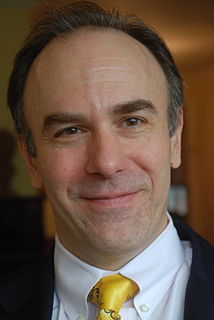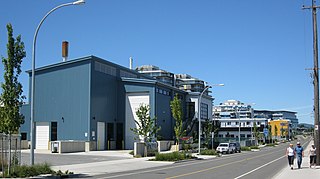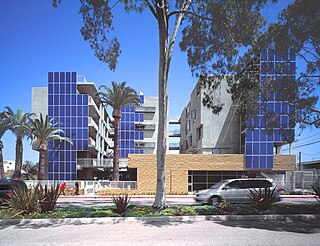Related Research Articles

Green building refers to both a structure and the application of processes that are environmentally responsible and resource-efficient throughout a building's life-cycle: from planning to design, construction, operation, maintenance, renovation, and demolition. This requires close cooperation of the contractor, the architects, the engineers, and the client at all project stages. The Green Building practice expands and complements the classical building design concerns of economy, utility, durability, and comfort. In doing so, the three dimensions of sustainability, i.e., planet, people and profit across the entire supply chain need to be considered.

Leadership in Energy and Environmental Design (LEED) is a green building certification program used worldwide. Developed by the non-profit U.S. Green Building Council (USGBC), it includes a set of rating systems for the design, construction, operation, and maintenance of green buildings, homes, and neighborhoods, which aims to help building owners and operators be environmentally responsible and use resources efficiently. By 2015, there were over 80,000 LEED-certified buildings and over 100,000 LEED-accredited professionals. Most LEED-certified buildings are located in major U.S. metropolises. LEED Canada has developed a separate rating system adapted to the Canadian climate and regulations.

The U.S. Green Building Council (USGBC), co-founded by Mike Italiano, David Gottfried and Rick Fedrizzi in 1993, is a private 501(c)3, membership-based non-profit organization that promotes sustainability in building design, construction, and operation. USGBC is best known for its development of the Leadership in Energy and Environmental Design (LEED) green building rating systems and its annual Greenbuild International Conference and Expo, the world’s largest conference and expo dedicated to green building. USGBC was one of eight national councils that helped found the World Green Building Council (WorldGBC). The current president and CEO is Peter Templeton.

The Canada Green Building Council (CaGBC) was created in 2003 to further the expansion of green building in Canada. Prior to the formation of the Council, Canada had participated in the United States Green Building Council (USGBC) through British Columbia's membership in the USGBC's Cascadia Chapter.

Robert "Rob" Watson, is a market transformation expert, international leader in the green building movement and CEO and chief scientist of The ECON Group. He founded the LEED Green Building Rating System of the United States Green Building Council (USGBC) in 1993 and was its founding chairman until 2006.
Wainwright Bank was a nationally recognized socially progressive bank in Boston, lauded as a "rebel with a cause making its reputation as a champion of social-justice causes, throwing its support behind everything from the gay-rights movement and affordable housing initiatives to immigration reform and the anti-Iraq war movement." There are 12 branch offices in Boston, Cambridge, Brookline, Newton, Watertown and Somerville. The current president is Jan A. Miller. Wainwright has made community development, affordable housing, civil and human rights, and other social issues a prominent focus of its activities and has a documented history of leadership in supporting social justice efforts. Wainwright was featured in three recent books on this topic: in 2005, Megatrends 2010: The Rise of Conscious Capitalism by Patrician Aburdene; in 2006, named as a “truly responsible and highly profitable firm that is changing business now” in The High Purpose Company by Christine Arena; and in 2008 in the Soul of a Leader by Margaret Benefiel PhD, CEO of Executive Soul and a teacher of spirituality and leadership at Andover Newton Theological School.

Green Business Certification Inc. (GBCI) is an American organization that provides third-party credentialing and verification for several rating systems relating to the built environment. It was established as the Green Building Certification Institute in January 2008 with the support of the U.S. Green Building Council to provide independent oversight of the Leadership in Energy and Environmental Design (LEED) project certification and professional credentialing processes. The organization's current name was adopted on 16 April 2015 after the organization starts to provide third-party certification for the International WELL Building Institute's evidence-based building standard WELL Building Standard on 4 April 2014, the Perfect Power Institute's PEER standard, and the Global Real Estate Sustainability Benchmark.

Dockside Green is a 1,300,000-square-foot (120,000 m2) mixed-use community in Victoria, British Columbia, Canada owned by Vancity Credit Union and noted for its strict adherence to the principles of sustainable architecture or green building.
This article provides examples of green building programs in the United States. These programs span the public, private, and non-profit sectors, and all have the goal of increasing energy efficiency and the sustainability of the built environment.
In historic preservation, sustainable preservation is the idea that preservation has tangible ecological benefits, on the basis that the most sustainable building is one that is already built. Historic buildings can have advantages over new construction with their often central location, historic building materials, and unique characteristics of craftsmanship. Arguing for these connections is at least partially an outgrowth of the green building movement with its emphasis on new construction. Sustainable preservation borrows many of the same principles of sustainable architecture, though is unique by focusing on older buildings versus new construction. The term "sustainable preservation" is also utilized to refer to the preservation of global heritage, archaeological and historic sites through the creation of economically sustainable businesses which support such preservation, such as the Sustainable Preservation Initiative and the Global Heritage Fund.

Colorado Court Housing is a 44-unit housing project designed by the architectural firm Pugh + Scarpa. Colorado Court is the first United States Green Building Council (USGBC) "LEED" certified multi-family housing project, achieving "Gold" certification. Located at the corner of a main offramp of the Santa Monica freeway, Colorado Court's highly visible position makes it gateway to the city of Santa Monica, California. The 44-unit, five-story building is the first affordable-housing project the United States to be LEED certified and is nearly 100% energy neutral (Colorado Court Movie Clip). This project is an excellent model of sustainable development in an urban environment, provides a model for private/public partnerships benefit the community, and promotes diversity in an urban environment through strategically placed affordable housing.
Green building on college campuses is the purposeful construction of buildings on college campuses that decreases resource usage in both the building process and also the future use of the building. The goal is to reduce CO2 emissions, energy use, and water use, while creating an atmosphere where students can be healthy and learn. Universities across the country are building to green standards set forth by the USGBC, United States Green Building Council. The USGBC is a non-profit organization that promotes sustainability in how buildings are designed and built. This organization created the Leadership in Energy and Environmental Design (LEED) rating system, which is a certification process that provides verification that a building is environmentally sustainable. In the United States, commercial and residential buildings account for 70 percent of the electricity use and over 38 percent of CO2 emissions. Because of these huge statistics regarding resource usage and emissions, the room for more efficient building practices is dramatic. Since college campuses are where the world's future leaders are being taught, colleges are choosing to construct new buildings to green standards in order to promote environmental stewardship to their students. Colleges across the United States have taken leading roles in the construction of green building in order to reduce resource consumption, save money in the long run, and instill the importance on environmental sustainability on their students. It is a better way to motivate new generation to live a sustainable life.
The LEED Professional Exams are administered by the Green Business Certification Inc. (GBCI) for professionals seeking to earn credentials and certificates. The exams test knowledge based on the U.S. Green Building Council's Leadership in Energy and Environmental Design (LEED) Rating Systems.

"Sustainability," was defined as “development which implies meeting the needs of the present without compromising the ability of future generations to meet their own needs”as defined by the 1983 Brundtland Commission. As sustainability gains support and momentum worldwide, universities across the United States have expanded initiatives towards more sustainable campuses, commitments, academic offerings, and student engagement.

Sustainable urbanism is both the study of cities and the practices to build them (urbanism), that focuses on promoting their long term viability by reducing consumption, waste and harmful impacts on people and place while enhancing the overall well-being of both people and place. Well-being includes the physical, ecological, economic, social, health and equity factors, among others, that comprise cities and their populations. In the context of contemporary urbanism, the term cities refers to several scales of human settlements from towns to cities, metropolises and mega-city regions that includes their peripheries / suburbs / exurbs. Sustainability is a key component to professional practice in urban planning and urban design along with its related disciplines landscape architecture, architecture, and civil and environmental engineering. Green urbanism and ecological urbanism are other common terms that are similar to sustainable urbanism, however they can be construed as focusing more on the natural environment and ecosystems and less on economic and social aspects. Also related to sustainable urbanism are the practices of land development called Sustainable development, which is the process of physically constructing sustainable buildings, as well as the practices of urban planning called smart growth or growth management, which denote the processes of planning, designing, and building urban settlements that are more sustainable than if they were not planned according to sustainability criteria and principles.

Mindspace is a brand of commercial and industrial parks established by K Raheja Corp. Located in Mumbai, Hyderabad, Chennai and Pune, the industrial hubs offer offices, residential towers, entertainment facilities and other retail businesses. By 2016, the parks developed by Mindspace housed more than 50 businesses in India, including Accenture, L&T Infotech Ltd, Cognizant Technology and Capegemini Group.

The Terry Thomas Building, located in the South Lake Union neighborhood of Seattle, Washington is a sustainable, LEED-certified office building completed in 2008. The Terry Thomas is Seattle's first commercial office building structure developed in decades without central air conditioning. It was designed by Seattle-based architectural firm Weber Thompson, who also designed the interiors of the building and use it as their headquarters.

In the fields of engineering and construction, resilience is the ability to absorb or avoid damage without suffering complete failure and is an objective of design, maintenance and restoration for buildings and infrastructure, as well as communities. A more comprehensive definition is that it is the ability to respond, absorb, and adapt to, as well as recover in a disruptive event. A resilient structure/system/community is expected to be able to resist to an extreme event with minimal damages and functionality disruptions during the event; after the event, it should be able to rapidly recovery its functionality similar to or even better than the pre-event level.
The Green Parking Council (GPC), a nonprofit organization and affiliate of the International Parking Institute provided leadership and oversight for the green conversion of parking facilities to sustainable, environmentally responsible assets. GPC expanded green parking practices and promoted sustainable urban mobility through its Certified Green Garage rating system. The Certified Green Garage rating system was acquired by the United States Green Building Council (USGBC) and is administered by the Green Business Certification Inc. (GBCI), the certification arm of the USGBC. Rebranded and launched as the Parksmart rating system, Parksmart is now aligned with the full suite of LEED programs under the USGBC organization.

Green building certification systems are a set of rating systems and tools that are used to assess a building or a construction project's performance from a sustainability and environmental perspective. Such ratings aim to improve the overall quality of buildings and infrastructures, integrate a life cycle approach in its design and construction, and promote the fulfillment of the United Nations Sustainable Development Goals by the construction industry. Buildings that have been assessed and are deemed to meet a certain level of performance and quality, receive a certificate proving this achievement.
References
- ↑ "LEED certification for neighborhood development | U.S. Green Building Council".
- ↑ https://www.usgbc.org/sites/all/assets/section/files/v4-guide-excerpts/Excerpt_v4_ND.pdf [ bare URL PDF ]
- ↑ https://www.usgbc.org/sites/all/assets/section/files/v4-guide-excerpts/Excerpt_v4_ND.pdf [ bare URL PDF ]
- ↑ https://www.usgbc.org/sites/all/assets/section/files/v4-guide-excerpts/Excerpt_v4_ND.pdf [ bare URL PDF ]
- ↑ Howe, J. Cullen., et al. “Chapter Eight: Site Selection and Land Use Planning.” The Law of Green Buildings: Regulatory and Legal Issues in Design, Construction, Operations, and Financing, American Bar Association, Section of Environment, Energy, and Resources, 2010, p. 199.
- ↑ Wheeler, Stephen M. "Chapter 14: Green Architecture and Building", Planning for Sustainability: Creating Livable, Equitable and Ecological Communities, 2nd ed., Routledge, 2013, pp. 194–196.
- ↑ "LEED credits, prerequisites and points: How are they different? | U.S. Green Building Council".
- ↑ http://www.usgbc.org/ShowFile.aspx?DocumentID=6423 [ bare URL ]